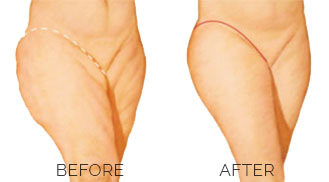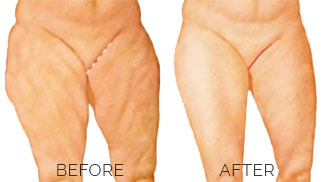Loose and sagging skin in the area of the inner and outer thighs can make some people self-conscious about their legs. They might avoid wearing shorts or bathing suits, or have a difficult time finding clothes that fit correctly. In addition to making some people feel unattractive, excess skin in the thighs can cause uncomfortable rubbing and chafing that can lead to rashes, sores and even infections. Sometimes excess thigh skin is a genetic "family curse" handed down through the generations. In other cases, hanging skin in the thighs is the result of rapid and dramatic weight loss. The frustrating truth is that no matter how hard you've worked to lose weight and get into shape, when stretched skin loses its elasticity, diet and exercise can't eliminate that extra, hanging skin.
For some people, surgery can help. A thigh lift is a surgical procedure to remove excess, flabby skin on the thighs. With a thigh or lower body lift, it is possible to tighten skin and give your legs a smoother, shapelier contour. Surgery is not right for everybody, and Dr. Constantine will explain the benefits and risks associated with thigh lift surgery so that you can make an informed decision.


There are different types of thigh lifts to address different problem areas. Thigh lifts that target the inner thighs can help improve the shape of your inner thigh, while eliminating the discomfort of rubbing and chafing. To improve the shape of your outer thighs, a belt lipectomy might be the answer. A belt lipectomy is a procedure designed to tighten the skin by removing a "belt" of skin all the way around the body, thus raising the buttocks, hips and thighs to a more youthful position. While thigh lift procedures produce beautiful and long-lasting results, it's important to realize that you will have scars after your surgery. In many cases, scars can be hidden in relatively inconspicuous areas, and most patients are willing to exchange scars for firmer, younger looking thighs.
Other Areas of Interest






